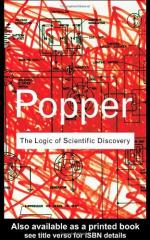|
This section contains 817 words (approx. 3 pages at 400 words per page) |

|
Part II: Chapter 6, Degrees of Testability Summary and Analysis
In selecting a theory, the degree of testability is a most significant factor. Testability is directly linked to falsification. This chapter investigates comparisons of classes of potential falsifiers to be used in testing theories. Popper states that the amount of empirical information conveyed by a theory increases with its degree of falsifiability. The number of possible events, permitted or not, is infinite. Therefore the aim of theoretical science is to obtain theories that have a narrow range of basic statements that are not forbidden and are easily falsifiable. These theories hold the greatest promise to advance scientific knowledge because they offer the greatest precision in what is actually encountered and observed.
Popper considers the argument made by many theorists that precise meaning is given to classes of events through the power...
(read more from the Part II: Chapter 6, Degrees of Testability Summary)
|
This section contains 817 words (approx. 3 pages at 400 words per page) |

|




